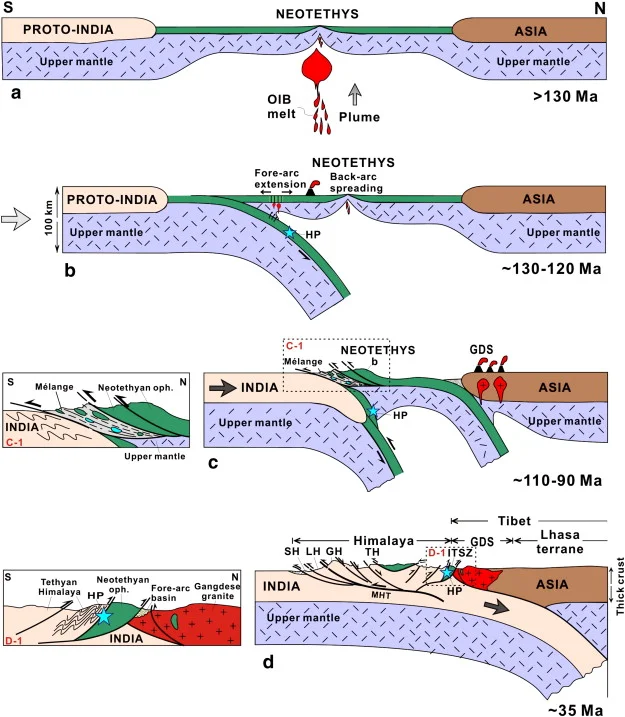Himalayan Geology / Tectonics
Most of us are aware of the process of the formation of the Himalayas which were formed by the Collision and subsequent subduction between the Indian Plate and the Eurasian Plate. But that's about all we care to know. Well most of us though.
Now here is a splendid map that shows the Geology as well as the Tectonics of the Himalayas and how actually the boundaries are defined. It also shows the distinction between the Lesser Himalayas / the Greater Himalayas / the Tethys Himalayas / the Trans Himalayas as well as the Karakorams. It is very complicated as well and took me, an Amatuer, a lot of time to really figure out this stuff. But the more you understand the more interesting it becomes.
Some points I will run you through so that you also get a basic handle on this rather complicated Map. Many times a fundamental question is asked, are the Karakorams a part of the Himalayas ? Well the answer based on Geology and Tectonics is that its not. The Indus Tsangpo suture lies between the Tethys Himalayas on one side of the suture and the Karakoram-Tibet on the other side.
You can see the Thrust lines marked with little arrows. The main one in front in the Main Mantle Thrust which more or less follows the Indus Tsangpo suture. In simpler words the Indus and the Tsangpo (called the Brahmaputra in India) flow along the Main Mantle Thrust. However the Main Karakoram Thrust deviates as a separate fault form somewhere near the Pangong Lake. It from there on follows a course of its own. Where as the Main Mantle Thrust follows the Indus (it's actually the other way round) till beyond the Nanga Parbat which is considered the Western anchor of the Himalayas. And on the Eastern side the Namche Barwa is the considered the Eastern end of the Himalayas.
And then you can also see that the Salt Range in the Punjab is the youngest sub-Range of the Himalayan System. And interestingly it also shows Himalayan Tethyan sequence as the Blue colour indicates.
Another diagram shows how the Indian plate subducted under the Eurasian Plate. And how the Tethys Himalayas was formed when a part of the Ocean Floor was uplifted and placed right on the top between the Great Himalayas and the Tibet mainland. As the diagram shows the Indian plate is subducting or sliding under the Asian plate and this isn't without some friction. And this friction and this to and from between the two land masses resulted in the emergence of the Himalayas. And the subduction still continues and the Himalayas continue to rise and as per experts the rise is maximum in the Nanga Parbat region as it lies on the edge and gets pressure from the other side as well.
Some of the terms used explained in simple terms from various sources from the Net :
Faults : A fault is simply a fracture in a layer of Rocks or a discontinuity or a separation if you may. And these are the hot-spots where all the Tectonic and subsequently Volcanic eruptions. Think of faults as the Borders between two masses which are constantly changing and engaging each other. Besides the Main Thrusts (Main Frontal / Main Boundary / Main Central / Main Mantle / Main Karakoram ) there are smaller localised Thrusts named properly in this map with the local annotations which makes it more fascinating.
Ophiolites : Ophiolites are pieces of oceanic plate that have been thrusted (obducted) onto the edge of continental plates. They provide models for processes at mid-ocean ridges. Ophiolites are an assemblage of mafic and ultramafic lavas and hypabyssal rocks found in association with sedimentary rocks like greywackes and cherts.
STD Klippe : A klippe (German for cliff or crag) is a geological feature of thrust fault terrains. The klippe is the remnant portion of a nappe after erosion has removed connecting portions of the nappe. This process results in an outlier of exotic, often nearly horizontally translated strata overlying autochthonous strata.
Nappe : In geology, a nappe or thrust sheet is a large sheetlike body of rock that has been moved more than 2 km (1.2 mi) or 5 km (3.1 mi) above a thrust fault from its original position. Nappes form in compressional tectonic settings like continental collision zones or on the overriding plate in active subduction zones. Nappes form when a mass of rock is forced (or "thrust") over another rock mass, typically on a low angle fault plane. The resulting structure may include large-scale recumbent folds, shearing along the fault plane, imbricate thrust stacks, fensters and klippe.
MCT Windows : A tectonic window (Fenster in German) is a geological structure formed by the erosion or by normal faulting on a thrust system. A huge sheet of rock mass (hanging wall block) that has been transported to a considerable distance by movement along the thrust is called a nappe

